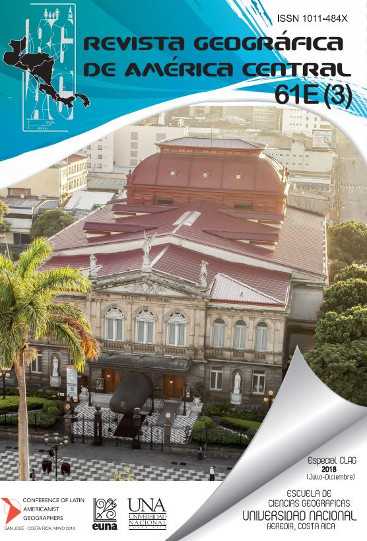Territorial structure of astronomical tourism in the region of Coquimbo, Chile
DOI:
https://doi.org/10.15359/rgac.61-3.10Keywords:
Special interest tourism, astronomical tourism, territorial structure, Coquimbo, ChileAbstract
Astronomical tourism, a segment of the tourism of special interests, made its debut in the international arena just a couple of decades ago. This type of tourism can only be practiced in certain areas of the world where latitude, altitude, climate and the quality of atmosphere contribute to generate the natural conditions specifically needed to observe the celestial dome. The Norte Chico in Chile is a privileged region in this respect, since its relative location on Earth, the dominant dry climate, as well as the infrastructure available and accessibility to observatories (scientific or otherwise) has given way to the expansion of astronomical tourism in several locations within the Coquimbo region, a part of Norte Chico. This paper deals with the issue of territorial structure, a geographical fundamental concept, useful to explaining the expansion of astronomical tourism in this part of Chile. In doing so, nuclei, flows and surfaces created by this type of tourism economy are revealed.
References
Barrado, A. (2004). Ordenación territorial y desarrollo turístico. Posibilidades, modelos y esquemas de ordenación territorial del turismo en España. Instituto de Estudios Turísticos, España, en Estudios Turísticos, No. 149, pp. 3 - 22.
Barraza, F. y González, S. (2012). Diseño de planes de acción para integrar el producto turismo astronómico dentro de la oferta turística de la región de Coquimbo. Universidad de La Serena, Chile.
Barrientos, F. y López, S. (2008). Con ojos de gigantes. La observación astronómica en el siglo XXI. Ediciones B. Chile.
Brotherton, B. y B. Himmetoglu (1997). Beyond destinations—special interest tourism, en Anatolia: an International Journal of Tourism and Hospitality Research, Vol. 8, No.3, pp. 11-30.
Cinzano, P., Falchi, F. y Elvidge, D. (2001). The first world atlas of the artificial night sky brightness, Mon. Not. R. Astron. Soc. 328, pp. 689 - 707.
Espinoza, A., Llancaman, M. y Sandoval, H. (2014). Turismo de intereses especiales y Parques nacionales, en Estudios y perspectivas en turismo, Vol. 23, pp. 115 - 130.
Galaz, G. (2001). Astronomía y desarrollo regional: Un cielo lleno de oportunidades, en Rev. Ambiente y Desarrollo, Ambiente hoy, Vol. XVII. No. 3, pp. 38 - 43.
Garibay, A. (2014). Estructura territorial del turismo en el Parque Nacional Volcán Irazú, Costa Rica. Tesis de Licenciatura en Geografía. Facultad de Filosofía y Letras, UNAM, México.
Hernández, C. y Murcio, R. (2004). Estudio de indicadores ONU-Habitat para los observatorios urbanos locales de las ciudades mexicanas, SEDESOL, ONU-Habitat México.
INE (2011). Informe económico regional, Julio – septiembre, Chile.
IN. (2014). Boletín de alojamiento turístico región de Coquimbo, Diciembre, 2014, Chile.
Kruja, D. y Gjyrezi, A. (2011). The Special Interest Tourism. Development and small regions, en Turizam, Vol. 15, pp. 77 - 89.
Lépez, H. y Torre, G. (2007). Patrimonio cultural astronómico como recurso turístico, en Jornadas Patrimonio y turismo, FFHyA, San Juan, Argentina.
Ministerio de Obras Públicas (MOP), (2016). Aeródromo La Florida de La Serena. Gobierno de Chile.
Newsome, D., S. Moore y R. Dowling (2012). Natural area tourism. Ecology, impacts and management. Chanel View Publications, 2da edición, Canadá.
Observatorio Astronómico Cruz del Sur (2014). Imágenes del Observatorio Cruz del Sur. Recuperado: [http://observatoriocruzdelsur.cl/index.php/observatorio/galeria-de-imagenes: 24 de junio de 2015].
OPCC (s/a). Protegiendo los cielos del norte de Chile: Patrimonio ambiental y cultural, Recurso didáctico, Oficina de Protección de la Calidad del Cielo del Norte de Chile, Chile.
Páramo, J. (2015). Estructura territorial del turismo astronómico en la Región de Coquimbo, Chile. Tesis de Licenciatura en Geografía. Facultad de Filosofía y Letras, UNAM, México.
Ramírez, A., Corco, C., Jaque, M. y Lazo, W. (2011). Un sol en el día y millones de soles en la noche: Astronomía en la Región de Coquimbo, Universidad de la Serena, Chile.
Raymond, W. (2013). El cielo ya no puede esperar. Turismo astronómico en el Parque Nacional “El leoncito”. Recuperado en: [http://suite101.net/article/el-cielo-ya-no-puede-esperar-a13135#.VMm6HWiG-So: 15 de abril de 2015].
SERNATUR (2011). Plan para el desarrollo turístico de la región de Coquimbo 2011 - 2014. Servicio Nacional de Turismo, Chile.
SERNATUR (2012a). Atractivos turísticos 2012, Chile.
SERNATUR (2012b). Turismo astronómico, SERNATUR región de Coquimbo, Chile.
SERNATUR (2016). Llegada de turistas extranjeros, agosto 2016. Chile.
SERNATUR / Turismo región de Coquimbo (2013), Conoce la ruta de las 7 maravillas turísticas de la región de Coquimbo, Chile.
Trauer, B. (2006). Conceptualizing special interest tourism – frameworks for analysis, en Tourism Management. University of Queensland. Australia, pp. 183 - 200.
Viterbo, A. (2012). La Exposición como medio de promoción y difusión de la Ruta Astronómica de la Cuarta Región, Universidad de Chile.
Weaber, D. (2011). Celestial ecotourism: new horizons in nature-based tourism, en Journal of Ecotourism Vol. 10, No. 1. March, pp. 38 - 45.
Downloads
Published
How to Cite
Issue
Section
License
Proposed policy for journals offering Open Access
Authors publishing their works in the Journal acknowledge and agree to the following terms:
a) Authors retain the copyrights to their works and guarantee the Journal the right to be the first to publish their works, under the Creative Commons License Attribution-NonCommercial-ShareAlike 4.0 International, CC BY-NC-SA 4.0 International (https://creativecommons.org/licenses/by-nc-sa/4.0/deed.es), which allows others to share works upon complying with the acknowledgment of authorship and mention of the Journal as the original publisher of the work.
b) Authors are permitted to separately establish additional agreements for the non-exclusive distribution of the official edition of the work published in the Journal (for example, authors may desire to place the work in an institutional repository or incorporate it into a book that is to published elsewhere) so long they acknowledgment to recognize the Journal as the original publisher. The aforementioned additional agreements must respect the terms of the non-profit character and sharing philosophy of the original license (CC BY-NC-SA 4.0 International, https://creativecommons.org/licenses/by-nc-sa/4.0/deed.es).
c) Authors are encouraged to archive the post-print or editor/PDF version in Open Access repositories.






 REVGEO is licensed under https://creativecommons.org/licenses/by-nc-sa/4.0/deed.es
REVGEO is licensed under https://creativecommons.org/licenses/by-nc-sa/4.0/deed.es
.svg_4.png)

_(1).png)
_(1)_(1)_(1)_1.png)
(2)(1)(1)(1).png)
